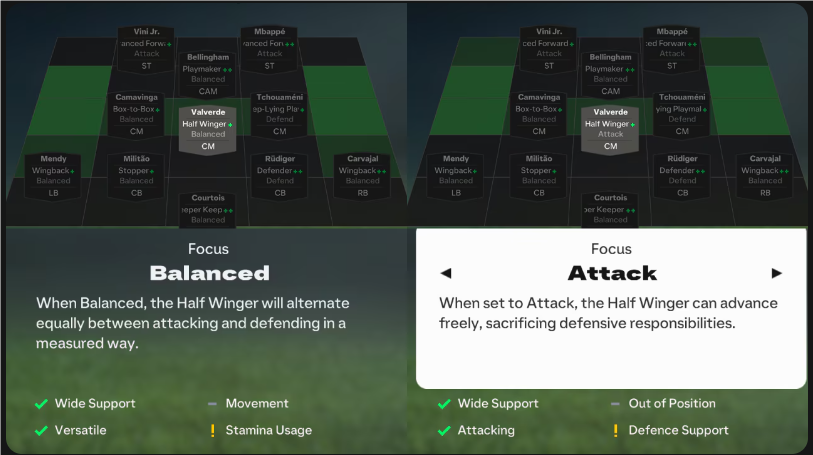FC 25 Player Role: Half-Winger (CM)
In EA SPORTS FC™ 25, the Half-Winger is a versatile midfielder who provides width while playing centrally. This unique role is perfect for teams looking to stretch the opposition, as the Half-Winger moves out wide to create space for attacking runs and build-up play. It is a role most effective in a midfield three, where the player can use their positioning to offer both offensive and defensive support.
Player Role: Half-Winger
- Position: Centre Midfielder (CM)
- Focus: Attack, Balanced
The Half-Winger operates in a hybrid role, covering central areas but frequently drifting wide to offer support on the flanks. This role is particularly effective for teams needing width and creativity without sacrificing central control. The Half-Winger’s ability to move laterally while playing centrally provides tactical flexibility and makes them an important link between defense and attack.

Key Characteristics of the Half-Winger:
- Width and Central Play: The Half-Winger offers wide support while maintaining their central positioning, balancing both roles to assist in build-up play and defense.
- Flank Runs: This midfielder will often overlap or underlap wide players to create additional attacking opportunities on the wings.
- Positional Flexibility: Whether attacking or defending, the Half-Winger adapts to the team’s needs, making them an all-round contributor to both phases of play.
Focus: Attack
When the Half-Winger is set to Attack, they will primarily focus on moving forward and creating attacking opportunities. Their wide positioning allows them to stretch the opposition, giving them the freedom to drift to the wings and provide crosses or support. However, with an attack focus, the Half-Winger sacrifices some defensive duties, staying forward to help the team in offensive transitions.
Attack Focus:
- Wide Support (+): The Half-Winger focuses on stretching the pitch by moving out wide, offering a passing option or delivering crosses into the box.
- Attacking (+): They will frequently join in attacking plays, pushing forward to offer an additional offensive outlet.
- Out of Position (=): Due to their attacking mindset, the Half-Winger may be caught out of position when the opposition counters, leaving the midfield exposed.
- Defence Support (-): Minimal defensive contribution as they focus primarily on advancing play and creating opportunities.
Focus: Balanced
With a Balanced focus, the Half-Winger is expected to provide both offensive and defensive contributions. They will alternate between supporting attacks and dropping back to defend when necessary. This focus allows them to maintain positional discipline while also contributing to the team’s build-up play. It’s ideal for teams looking for a midfielder who can handle multiple tasks.
Balanced Focus:
- Wide Support (+): The Half-Winger will still offer width but in a more measured way, balancing their wide runs with central support.
- Versatile (+): The Half-Winger can switch between attack and defense seamlessly, making them adaptable to different phases of the game.
- Movement (=): Their movement will be strategic, alternating between advancing forward and falling back to cover the midfield.
- Stamina Usage (-): The Half-Winger’s energy will be taxed due to their constant switching between attack and defense, meaning stamina conservation can become a factor in longer matches.
Positional Tendencies and Role Impact
The Half-Winger is a role that thrives in a midfield three, where the player can drift to the side of their weaker foot. A left-sided Half-Winger will naturally move to the left to offer width, while a right-sided Half-Winger will drift right. This tactical flexibility allows the Half-Winger to exploit space on the flanks, but it also requires strong positional awareness to avoid leaving gaps in the midfield when the team loses possession.
The Half-Winger‘s contributions are felt most during transitions. In attack, they provide additional options for wide runs, supporting wingers and full-backs to create overloads on the wings. In defense, they return centrally to cover the midfield, offering an extra body to prevent counter-attacks.
Other Characteristics of the Half-Winger:
- Stay Wide: The Half-Winger tends to stay close to the touchline when their team is in possession, providing width in build-up play.
- Overlap Runs: They often make overlapping runs past wide players to offer another attacking option down the flanks.
- Underlap Runs: At times, the Half-Winger can also cut inside and make underlap runs to create space for overlapping full-backs or wingers.
Summary
In FC 25, the Half-Winger offers a dynamic and versatile option for managers looking to add width and creativity to their midfield. Whether focused on Attack or playing a more Balanced role, the Half-Winger provides key support to both defensive and attacking phases, making them essential in systems that require fluidity and flexibility. While they offer width and attacking support, managers must be mindful of their defensive responsibilities, especially when using them in an attacking capacity.
Similar Posts
- PoE Bold Undertakings
- FC 25: Estadio Presidente Perón Stadium Overview
- Diablo 4 Dampen Layer Passive Skill: Fortifying Your Sorcerer’s Defenses
- PoE Achieving the Gilded Goals Challenge
- PoE Settlers Meaningful Mechanics 3.25
- Diablo 4 Expert Difficulty
- PoE Backup Cache – Duplicated Currency Items
- FC 25: Estadio Libertadores de América-Ricardo Enrique Bochini Stadium Overview
- PoE Indiscriminate Revenge – Path of Exile
- PoE Become the Darkness quest
- PoE Vaal Power Siphon Build 3.25 – Path of Exile: Settlers of Kalguur
- PoE Bound Rune – Path of Exile
- Investment Opportunity in EA Sports College Football 25 Ultimate Team
- PoE Black Thumb
- Craft Your Perfect Flask: The Power of PoE Instilling Orbs